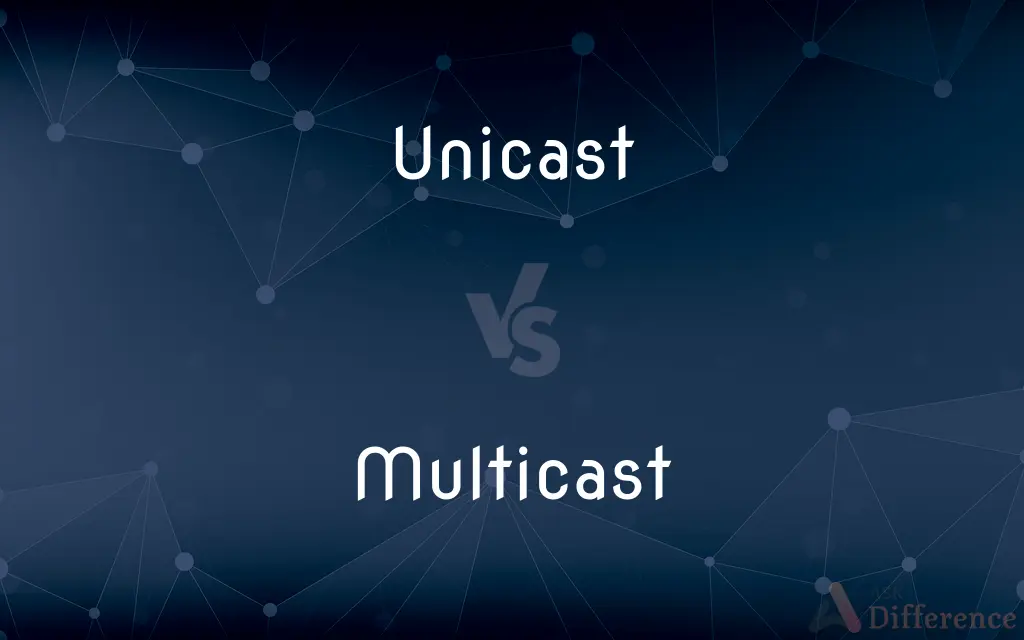Unicast vs. Multicast — What's the Difference?
By Tayyaba Rehman & Maham Liaqat — Updated on March 25, 2024
Unicast involves one-to-one communication, while multicast refers to one-to-many transmission.

Difference Between Unicast and Multicast
Table of Contents
ADVERTISEMENT
Key Differences
Unicast is a communication protocol where information is sent from one sender to one specific receiver across a network, typical in most Internet communications. In contrast, multicast allows a single sender to transmit data to multiple selected recipients simultaneously, optimizing bandwidth for group communication scenarios.
While unicast traffic might lead to redundancy and increased network load when sending duplicate data to multiple recipients, multicast efficiently distributes the same data to multiple recipients without burdening the network unnecessarily. This makes multicast ideal for applications like streaming live events or updating software across multiple devices concurrently.
In terms of network configuration, unicast requires simpler setup with direct paths between sender and receiver, making it straightforward but potentially less efficient for broad distribution. Multicast, however, requires more complex network infrastructure to manage group memberships and ensure data reaches all intended recipients without impacting non-subscribers.
Unicast is widely used for web browsing, email, and file transfers, where direct and private communication is essential. Multicast is favored in applications like IPTV, online gaming, and live broadcasts, where the same content is simultaneously consumed by many users.
Despite its efficiency for certain applications, multicast's broader adoption is hindered by its complexity and the need for multicast-enabled network devices and protocols, limiting its use primarily to controlled or advanced network environments.
ADVERTISEMENT
Comparison Chart
Communication Type
One-to-one
One-to-many
Network Load
Increased with multiple recipients
Optimized for multiple recipients
Configuration Complexity
Simpler, direct paths
More complex, requires group management
Ideal Use Cases
Web browsing, email, file transfers
IPTV, online gaming, live broadcasts
Network Infrastructure
Requires standard network setup
Needs multicast-enabled devices and protocols
Compare with Definitions
Unicast
Direct communication between two devices.
Sending an email uses unicast to deliver the message to one recipient.
Multicast
Optimizes bandwidth for group communication.
Software updates for multiple devices can be sent via multicast to reduce network load.
Unicast
Predominant in standard Internet traffic.
Web browsing is based on unicast communication, requesting and receiving data individually.
Multicast
Efficient for sending data to multiple recipients.
Multicast is used to broadcast live sports events to numerous viewers simultaneously.
Unicast
Requires individual connections for multiple recipients.
Streaming a video to three devices requires three separate unicast streams.
Multicast
Complex setup for group management.
Managing multicast groups requires careful planning to ensure efficient data distribution.
Unicast
Widely supported and easy to implement.
Most network devices inherently support unicast without needing special configurations.
Multicast
Requires multicast-enabled network infrastructure.
Deploying multicast in a network involves configuring routers and switches to support IGMP.
Unicast
Simple network configuration.
Setting up a unicast connection involves straightforward IP addressing and routing.
Multicast
Limited by network support and compatibility.
The broader adoption of multicast is often restricted by the need for compatible network equipment.
Unicast
In computer networking, unicast is a one-to-one transmission from one point in the network to another point; that is, one sender and one receiver, each identified by a network address.Unicast is in contrast to multicast and broadcast which are one-to-many transmissions. Internet Protocol unicast delivery methods such as Transmission Control Protocol (TCP) and User Datagram Protocol (UDP) are typically used.
Multicast
In computer networking, multicast is group communication where data transmission is addressed to a group of destination computers simultaneously. Multicast can be one-to-many or many-to-many distribution.
Unicast
Being the transmission of messages to a single destination host on a packet switching network.
Multicast
Having multiple targets, such that a call to the delegate triggers a call to each target.
Building .NET Applications with C#
Unicast
(programming) singlecast
Multicast
The simultaneous transmission of data to several destinations on a network.
Unicast
To transmit in this manner.
Common Curiosities
In what scenarios is multicast preferred?
Multicast is preferred for live broadcasts, streaming media to multiple recipients, and any application where the same data needs to be efficiently distributed to many users.
Why would a network choose unicast over multicast?
A network might choose unicast for its simplicity and direct communication needs, especially for applications requiring privacy and individualized data exchange.
Can unicast and multicast coexist in the same network?
Yes, unicast and multicast can coexist, with network devices handling each type of traffic as needed based on the application and network configuration.
What is required to set up multicast in a network?
Setting up multicast requires multicast routing and group management protocols like IGMP, as well as multicast-enabled network hardware.
What is unicast communication?
Unicast communication is a one-to-one protocol where data is sent from one sender to a single receiver.
Why is unicast more commonly used than multicast?
Unicast's simplicity, ease of implementation, and widespread support make it more commonly used than multicast, which requires more complex infrastructure and setup.
How does multicast save bandwidth compared to unicast?
Multicast saves bandwidth by sending a single stream of data to multiple recipients, avoiding the need to duplicate and send individual streams to each recipient as in unicast.
What challenges does multicast face in terms of network infrastructure?
Multicast requires multicast-enabled routers and network devices, as well as complex setup and management of group memberships, which can be a barrier to its broader adoption.
Are there security differences between unicast and multicast?
Yes, unicast typically involves standard security measures for direct connections, while multicast may require additional security considerations due to its broader distribution nature.
How does multicast communication work?
Multicast communication allows a single sender to transmit data to multiple selected recipients simultaneously, using network infrastructure to manage data distribution efficiently.
How do applications choose between unicast and multicast?
Applications choose based on the nature of the data distribution: unicast for direct, individual communication, and multicast for efficient, broad distribution.
What is the impact of unicast on network performance?
Unicast can strain network performance when sending data to multiple recipients, as it requires separate connections and data streams for each recipient.
What advancements are being made in multicast technology?
Advancements include improved multicast routing protocols, better group management techniques, and enhanced support in consumer-grade network equipment.
Can multicast be used over the Internet?
While technically possible, multicast over the Internet is limited due to the need for widespread support across Internet service providers and the complexity of global multicast routing.
How do devices join a multicast group?
Devices join a multicast group through protocols like IGMP, where they express interest in joining a specific multicast group to receive the corresponding data streams.
Share Your Discovery

Previous Comparison
Affirm vs. Swear
Next Comparison
Fondue vs. FondantAuthor Spotlight
Written by
Tayyaba RehmanTayyaba Rehman is a distinguished writer, currently serving as a primary contributor to askdifference.com. As a researcher in semantics and etymology, Tayyaba's passion for the complexity of languages and their distinctions has found a perfect home on the platform. Tayyaba delves into the intricacies of language, distinguishing between commonly confused words and phrases, thereby providing clarity for readers worldwide.
Co-written by
Maham Liaqat















































